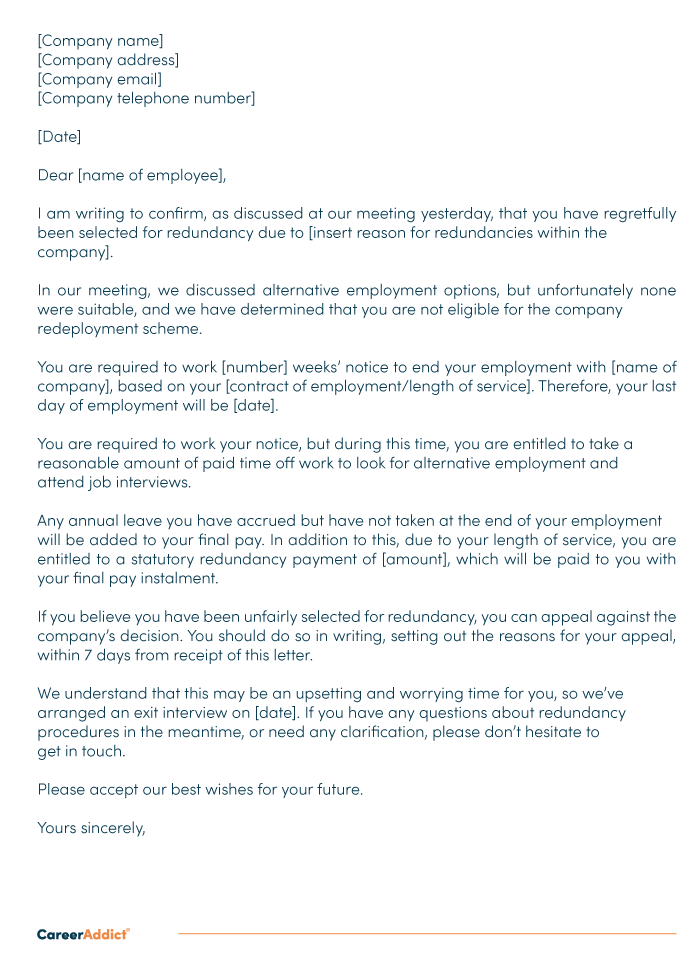Examining the Interplay In Between Firm Redundancy and Business Adaptability for Future Growth
In the vibrant landscape these days's service world, the detailed connection in between company redundancy and organizational versatility emerges as a vital factor for continual growth and success. Firms frequently deal with the challenge of striking a delicate balance in between keeping a degree of redundancy to minimize dangers and fostering adaptability to react quickly to the ever-evolving market needs. This delicate interplay holds the key to not only making it through in stormy times yet also thriving in the face of unpredictability. As we discover the complex measurements of this interplay, intriguing insights into exactly how organizations navigate these complexities to lead the way for future growth wait for.
Significance of Business Redundancy
Company redundancy is an important aspect that enhances business durability and reduces operational risks. By integrating redundancy procedures within the business structure, companies can better hold up against unanticipated disturbances and changes in the service setting. Redundancy functions as a strategic barrier, permitting business to adjust and react efficiently to unanticipated challenges without compromising vital operations.
One trick element of the importance of company redundancy is its role in making certain continuity throughout times of dilemma. When faced with abrupt changes or emergency situations, redundant systems, sources, or employees can tip in to maintain important functions and prevent widespread disturbances. This connection not just safeguards the company's credibility and consumer trust fund but additionally reduces monetary losses and operational downtime.

Approaches for Organizational Flexibility

One more crucial strategy is investing in technology and facilities that can sustain adaptability and scalability. Applying electronic devices, automation, and information analytics can improve procedures, boost efficiency, and offer valuable insights for informed decision-making. In addition, creating adaptable business structures that permit for quick adjustments to market dynamics and client demands is necessary for staying competitive in a rapidly advancing setting. By proactively identifying prospective disruptions and chances, organizations can proactively prosper and adjust in an ever-changing organization landscape.
Balancing Redundancy and Adaptability
Attaining a harmonious balance in between operational redundancy and organizational adaptability is paramount in navigating the intricacies of a dynamic business atmosphere. Redundancy within a business gives a safeguard, making sure continuity and security in operations. However, an extra of redundancy can result in ineffectiveness and prevent flexibility to changing market problems. On the various other hand, organizational flexibility enables companies to respond quickly to external interruptions and seize new chances. Striking the best balance in between redundancy and flexibility is a fragile process that requires a deep understanding of the company's objectives, sector characteristics, and risk tolerance.
To attain this balance, firms need to perform regular analyses of their operations to determine areas where redundancy is needed for risk mitigation and where flexibility can drive advancement and development. Applying versatile structures, Read Full Report fostering a society of continual understanding and enhancement, and urging open communication throughout all levels of the company are vital methods to integrate redundancy and flexibility successfully. By straightening these 2 critical elements, companies can place themselves for lasting development and success in an ever-changing organization landscape.
Study on Adaptation Success
In analyzing instances of successful business adjustment, it ends up being evident that the interaction in between operational redundancy and versatility is a defining consider forming durable companies. One engaging instance research is that of Netflix. Initially a DVD rental service, Netflix demonstrated exceptional flexibility by transitioning right into a streaming platform when digitalization interfered with the market. By tactically purchasing technology and content production, Netflix not only grew however survived in a rapidly advancing market. One more standout instance is Amazon. Beginning as an on-line book shop, Amazon continuously adapted its service design, increasing right into varied webpage industries such as cloud computer and fabricated knowledge. This versatility allowed Amazon to stay ahead of competitors and meet changing customer demands. Lastly, Adobe gives a notable image of successful adjustment. The firm shifted from marketing software application licenses to a subscription-based version, making sure repeating earnings streams and boosted customer engagement. These study emphasize the significance of functional redundancy paired with business versatility in promoting long-term growth and competition.
Structure Durability for Future Growth
Building strength for future development calls for a strategic alignment of functional procedures with market characteristics and emerging patterns. Business have to adjust to altering settings by promoting a culture of adaptability, development, and continuous enhancement. Resilience entails not just recuperating from obstacles however likewise proactively preparing for future challenges. One essential aspect of structure resilience is buying durable danger monitoring techniques to alleviate possible disruptions. This includes scenario preparation, expanding supply chains, and creating backup prepare for various backups (who pays redundancy money).
Moreover, fostering strong connections with stakeholders, such as clients, employees, providers, and the community, is vital for weathering unpredictabilities and why not try this out maintaining trust and assistance during turbulent times. Efficient interaction and openness play a vital duty in building resilience, as they aid assist in and straighten expectations cooperation in browsing unpredictabilities.
Moreover, organizations need to prioritize understanding and growth campaigns to upskill employees and outfit them with the essential tools to adapt to transforming situations. By purchasing their workforce, business can improve their versatility and agility, eventually enhancing their resilience for lasting future development.
Final Thought

In the dynamic landscape of today's business globe, the intricate connection between firm redundancy and business adaptability arises as a critical aspect for sustained development and success. Companies usually encounter the challenge of striking a fragile equilibrium between keeping a degree of redundancy to alleviate dangers and fostering versatility to respond quickly to the ever-evolving market demands.To accomplish this equilibrium, companies require to conduct regular assessments of their procedures to determine locations where redundancy is needed for threat reduction and where adaptability can drive advancement and growth.In final thought, the interaction between company redundancy and business flexibility is crucial for future development. Building strength via a mix of redundancy and versatility will certainly guarantee that firms are prepared for the difficulties of the future.
Comments on “Who Pays Redundancy Money? Comprehending Employer Duties in the UK”